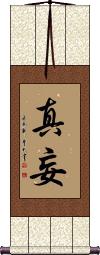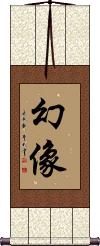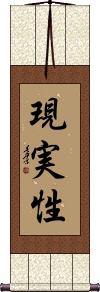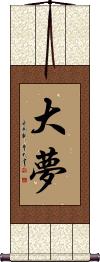Many custom options...
And formats...

Reality and Illusion in Chinese / Japanese...
Buy a Reality and Illusion calligraphy wall scroll here!
Personalize your custom “Reality and Illusion” project by clicking the button next to your favorite “Reality and Illusion” title below...
Reality and Illusion
Reality and Illusion
Buddhism Concept
Illusion
幻像 is a universal word for Illusion in Chinese, Japanese Kanji, and old Korean Hanja.
The first character means phantasm, vision, dream, illusion, apparition, or fantasy.
The second character means statue, picture, image, figure, portrait, shape, form, appearance, to be like, to resemble, to take after, to seem, or in rare/ancient context: an elephant.
![]() Note that the first character can be written without the left-side radical in Chinese. This form is shown to the right. Both forms are acceptable in Chinese but the character shown to the right is more likely to be read as "elephant."
Note that the first character can be written without the left-side radical in Chinese. This form is shown to the right. Both forms are acceptable in Chinese but the character shown to the right is more likely to be read as "elephant."
See Also: Reality
Reality / Realistic
現実性 is a Japanese word that expresses the idea of reality or coming to understand what is true and real.
This can also be translated as realistic, practical, or feasible.
See Also: Illusion
Life Is But A Dream
Big Dream
大夢 means “Big Dream” in Chinese and Japanese.
大夢 is primarily a Buddhist term referring to the great dream that represents a long and winding life that feels like a dream (since reality is an illusion anyway in Buddhism).
This can also be a female given name, Hiromu, or Oomu, in Japanese. Also, more rare unisex given names Daimu or Taimu.
Not the results for reality and illusion that you were looking for?
Below are some entries from our dictionary that may match your reality and illusion search...
| Characters If shown, 2nd row is Simp. Chinese |
Pronunciation Romanization |
Simple Dictionary Definition |
三德 see styles |
sān dé san1 de2 san te santoku |
The three virtues or powers, of which three groups are given below. (1) (a) 法身德 The virtue or potency of the Buddha's eternal, spiritual body, the dharmakāya; (b) 般若德 of his prājñā, or wisdom, knowing all things in their reality; (c) 解脫德 of his freedom from all bonds and his sovereign Iiberty. Each of these has the four qualities of 常, 樂我, 淨eternity, joy, personality, and purity; v. 漫涅槃經 (2) (a) 智德 The potency of his perfect knowledge; (b) 斷德 of his cutting off all illusion and perfecting of supreme nirvāṇa; the above two are 自利 for his own advantage; (c) 恩德 of his universal grace and salvation, which 利他 bestows the benefits he has acquired on others. (3) (a) 因圓德 The perfection of his causative or karmic works during his three great kalpas of preparation; (b) 果圓德 the perfection of the fruit, or results in his own character and wisdom; (c) 恩圓德 the perfection of his grace in the salvation of others. |
三惑 see styles |
sān huò san1 huo4 san huo sanwaku; sannaku さんわく; さんなく |
{Buddh} three mental disturbances A Tiantai classification of the three delusions, also styled 三煩惱; 三漏; 三垢; 三結; trials or temptations, leakages, uncleannesses, and bonds. The first of the following three is common to all disciples, the two last to bodhisattvas. They arise from (a) 見, 思, 惑 things seen and thought, i.e. illusions from imperfect perception, with temptation to love, hate, etc.; to be rid of these false views and temptations is the discipline and nirvāṇa of ascetic or Hīnayāna Buddhists. Mahāyāna proceeds further in and by its bodhisattva aims, which produce their own difficulties, i.e. (b) 塵沙惑 illusion and temptation through the immense variety of duties in saving men; and (c) 無明惑 illusions and temptations that arise from failure philosophically to understand things in their reality. |
二執 二执 see styles |
èr zhí er4 zhi2 erh chih nishū |
The two (erroneous) tenets, or attachments: (1) 我執 or 人執 that of the reality of the ego, permanent personality, the ātman, soul or self. (2) 法執 that of the reality of dharma, things or phenomena. Both are illusions. "All illusion arises from holding to the reality of the ego and of things." |
五觀 五观 see styles |
wǔ guān wu3 guan1 wu kuan gokan |
The five meditations referred to in the Lotus Sutra 25: (1) 眞 on the true, idem 空觀, to meditate on the reality of the void or infinite, in order to be rid of illusion in views and thoughts; (2) 淸淨觀 on purity, to be rid of any remains of impurity connected with the temporal, idem 假觀; (3) 廣大智慧觀 on the wider and greater wisdom, idem 中觀, by study of the 'middle' way; (4) 悲觀 on pitifulness, or the pitiable condition of the living, and by the above three to meditate on their salvation; (5) 慈觀 on mercy and the extension of the first three meditations to the carrying of joy to all the living. |
俗智 see styles |
sú zhì su2 zhi4 su chih zokuchi |
Common or worldly wisdom, which by its illusion blurs or colours the mind, blinding it to reality. |
十力 see styles |
shí lì shi2 li4 shih li jūriki |
Daśabala. The ten powers of Buddha, giving complete knowledge of: (1) what is right or wrong in every condition; (2) what is the karma of every being, past, present, and future; (3) all stages of dhyāna liberation, and samādhi; (4) the powers and faculties of all beings; (5) the desires, or moral direction of every being; (6) the actual condition of every individual; (7) the direction and consequence of all laws; (8) all causes of mortality and of good and evil in their reality; (9) the end of all beings and nirvāṇa; (10) the destruction of all illusion of every kind. See the 智度論 25 and the 倶舍論 29. |
我愚 see styles |
wǒ yú wo3 yu2 wo yü gagu |
Ego ignorance, holding to the illusion of the reality of the ego. |
我空 see styles |
wǒ kōng wo3 kong1 wo k`ung wo kung gakū |
生空 (衆生空); 人空 Illusion of the concept of the reality of the ego, man being composed of elements and disintegrated when these are dissolved. |
法性 see styles |
fǎ xìng fa3 xing4 fa hsing hosshou / hossho ほっしょう |
{Buddh} (See 法相・ほっそう・1) dharmata (dharma nature, the true nature of all manifest phenomena); (personal name) Hosshou dharmatā. Dharma-nature, the nature underlying all thing, the bhūtatathatā, a Mahāyāna philosophical concept unknown in Hīnayāna, v. 眞如 and its various definitions in the 法相, 三論 (or法性), 華嚴, and 天台 Schools. It is discussed both in its absolute and relative senses, or static and dynamic. In the Mahāparinirvāṇa sūtra and various śāstras the term has numerous alternative forms, which may be taken as definitions, i. e. 法定 inherent dharma, or Buddha-nature; 法住 abiding dharma-nature; 法界 dharmakṣetra, realm of dharma; 法身 dharmakāya, embodiment of dharma; 實際 region of reality; 實相 reality; 空性 nature of the Void, i. e. immaterial nature; 佛性 Buddha-nature; 無相 appearance of nothingness, or immateriality; 眞如 bhūtatathatā; 如來藏 tathāgatagarbha; 平等性 universal nature; 離生性 immortal nature; 無我性 impersonal nature; 虛定界: realm of abstraction; 不虛妄性 nature of no illusion; 不變異性 immutable nature; 不思議界 realm beyond thought; 自性淸淨心 mind of absolute purity, or unsulliedness, etc. Of these the terms 眞如, 法性, and 實際 are most used by the Prajñāpāramitā sūtras. |
法界 see styles |
fǎ jiè fa3 jie4 fa chieh hokkai; houkai / hokkai; hokai ほっかい; ほうかい |
(1) {Buddh} universe; (2) {Buddh} realm of thought; (3) {Buddh} underlying principle of reality; manifestation of true thusness; (4) (ほうかい only) (abbreviation) (See 法界悋気) being jealous of things that have nothing to do with one; being jealous of others who are in love with each other dharmadhātu, 法性; 實相; 達磨馱都 Dharma-element, -factor, or-realm. (1) A name for "things" in general, noumenal or phenomenal; for the physical universe, or any portion or phase of it. (2) The unifying underlying spiritual reality regarded as the ground or cause of all things, the absolute from which all proceeds. It is one of the eighteen dhātus. These are categories of three, four, five, and ten dharmadhātus; the first three are combinations of 事 and 理 or active and passive, dynamic and static; the ten are: Buddha-realm, Bodhisattva-realm, pratyekabuddha-realm, śrāvaka, deva, Human, asura, Demon, Animal, and Hades realms-a Huayan category. Tiantai has ten for meditaton, i.e. the realms of the eighteen media of perception (the six organs, six objects, and six sense-data or sensations), of illusion, sickness, karma, māra, samādhi, (false) views, pride, the two lower Vehicles, and the Bodhisattva Vehicle. |
理惑 see styles |
lǐ huò li3 huo4 li huo riwaku |
Illusion in regard to fundamental truth, e.g. the reality of the ego and things; as 事惑 is illusion in regard to things themselves. Also, fundamental illusion; reality and illusion. |
空定 see styles |
kōng dìng kong1 ding4 k`ung ting kung ting kūjō |
The meditation which dwells on the Void or the Immaterial; it is divided into 内道, i.e. the 三三昧, and 外道, the latter limited to the four dhyānas 四空定 q.v., except the illusion that things have a reality in themselves, as individuals 法我 q.v. |
見愛 见爱 see styles |
jiàn ài jian4 ai4 chien ai ken'nai |
(literary) to be so good as to show favor (to me); to regard (me) highly views and desires, e. g. the illusion that the ego is a reality and the consequent desires and passions; the two are the root of all suffering. |
賢者 贤者 see styles |
xián zhě xian2 zhe3 hsien che kenja; kensha けんじゃ; けんしゃ |
wise person; sage A good and wise man, not yet free from illusion or fully comprehending reality; also anyone occupying a superior position, or a good man in general. |
賢聖 贤圣 see styles |
xián shèng xian2 sheng4 hsien sheng kensei / kense けんせい |
(personal name) Kensei Those who are noted for goodness, and those who are also noted for wisdom, or insight; the xian are still of ordinary human standard, the sheng transcend them in wisdom and character; the attainments from 見道 upwards are those of the sheng; the xian is on the moral plane, and has not eliminated illusion; the sheng has cut of illusion and has insight into absolute reality. The Mahāyāna has three stages for the xian and ten for the sheng; the Hīnayāna has seven for each. |
見顚倒 见顚倒 see styles |
jiàn diān dào jian4 dian1 dao4 chien tien tao ken tendō |
To see things upside down; to regard illusion as reality. |
金剛定 金刚定 see styles |
jīn gāng dìng jin1 gang1 ding4 chin kang ting kongō jō |
vajrasamādhi, 金剛喩定; 金剛三昧; 金剛滅定 diamond meditation, that of the last stage of the bodhisattva, characterized by firm, indestructible knowledge, penetrating all reality; attained after all remains of illusion have been cut off. |
空即是色 see styles |
kuusokuzeshiki / kusokuzeshiki くうそくぜしき |
(yoji) {Buddh} (See 色即是空) emptiness is form; illusion of the reality of matter |
The following table may be helpful for those studying Chinese or Japanese...
| Title | Characters | Romaji (Romanized Japanese) | Various forms of Romanized Chinese | |
| Reality and Illusion | 現実と幻想 | gen jitsu to gen sou genjitsutogensou gen jitsu to gen so | ||
| Reality and Illusion | 真妄 | zhēn wàng zhen1 wang4 zhen wang zhenwang | chen wang chenwang |
|
| Illusion | 幻像 幻像 / 幻象 | gen zou / genzou / gen zo | huàn xiàng huan4 xiang4 huan xiang huanxiang | huan hsiang huanhsiang |
| Reality Realistic | 現実性 | gen jitsu sei genjitsusei | ||
| Life Is But A Dream | 人生如夢 人生如梦 | rén shēng rú mèng ren2 sheng1 ru2 meng4 ren sheng ru meng renshengrumeng | jen sheng ju meng jenshengjumeng |
|
| Big Dream | 大夢 | daimu | dà mèng / da4 meng4 / da meng / dameng | ta meng / tameng |
| In some entries above you will see that characters have different versions above and below a line. In these cases, the characters above the line are Traditional Chinese, while the ones below are Simplified Chinese. | ||||
Successful Chinese Character and Japanese Kanji calligraphy searches within the last few hours...









